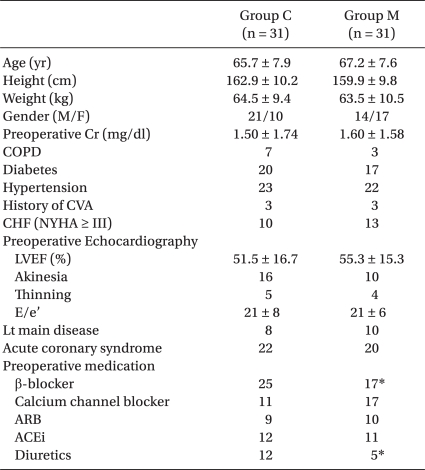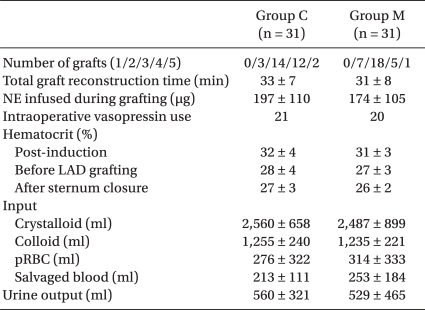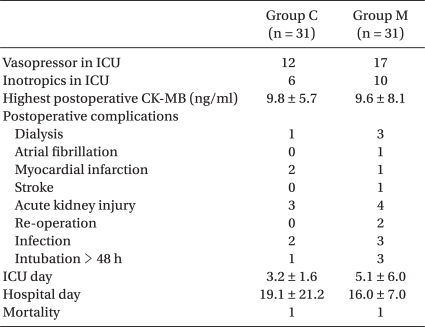1. Abu-Omar Y, Taggart DP. The present status of off-pump coronary artery bypass grafting. Eur J Cardiothorac Surg. 2009; 36:312–321. PMID:
19608042.

2. Chassot PG, van der Linden P, Zaugg M, Mueller XM, Spahn DR. Off-pump coronary artery bypass surgery: physiology and anaesthetic management. Br J Anaesth. 2004; 92:400–413. PMID:
14970136.
3. Ommen SR, Nishimura RA, Appleton CP, Miller FA, Oh JK, Redfield MM, et al. Clinical utility of Doppler echocardiography and tissue Doppler imaging in the estimation of left ventricular filling pressures: a comparative simultaneous Doppler-catheterization study. Circulation. 2000; 102:1788–1794. PMID:
11023933.
4. Dokainish H, Zoghbi WA, Lakkis NM, Al-Bakshy F, Dhir M, Quinones MA, et al. Optimal noninvasive assessment of left ventricular filling pressures: a comparison of tissue Doppler echocardiography and B-type natriuretic peptide in patients with pulmonary artery catheters. Circulation. 2004; 109:2432–2439. PMID:
15123522.

5. Shim JK, Choi YS, Chun DH, Hong SW, Kim DH, Kwak YL. Relationship between echocardiographic index of ventricular filling pressure and intraoperative haemodynamic changes during off-pump coronary bypass surgery. Br J Anaesth. 2009; 102:316–321. PMID:
19203992.

6. Skoyles JR, Sherry KM. Pharmacology, mechanisms of action and uses of selective phosphodiesterase inhibitors. Br J Anaesth. 1992; 68:293–302. PMID:
1547054.

7. Monrad ES, Baim DS, Smith HS, Lanoue A, Brauwald E, Grossman W. Effects of milrinone on coronary hemodynamics and myocardial energetics in patients with congestive heart failure. Circulation. 1985; 71:972–979. PMID:
3986984.

8. Monrad ES, Baim DS, Smith HS, Lanoue AS. Milrinone, dobutamine, and nitroprusside: comparative effects on hemodynamics and myocardial energetics in patients with severe congestive heart failure. Circulation. 1986; 73:III168–III174. PMID:
3510773.
9. Liu JJ, Doolan LA, Xie B, Chen JR, Buxton BF. Direct vasodilator effect of milrinone, an inotropic drug, on arterial coronary bypass grafts. J Thorac Cardiovasc Surg. 1997; 113:108–113. PMID:
9011679.

10. Lobato EB, Urdaneta F, Martin TD, Gravenstein N. Effects of milrinone versus epinephrine on grafted internal mammary artery flow after cardiopulmonary bypass. J Cardiothorac Vasc Anesth. 2000; 14:9–11. PMID:
10698384.

11. Kwak YL, Oh YJ, Shinn HK, Yoo KJ, Kim SH, Hong YW. Haemodynamic effects of a milrinone infusion without a bolus in patients undergoing off-pump coronary artery bypass graft surgery. Anaesthesia. 2004; 59:324–331. PMID:
15023101.

12. Kwak YL, Oh YJ, Kim SH, Shin HK, Kim JY, Hong YW. Efficacy of pre-emptive milrinone in off-pump coronary artery bypass surgery: comparison between patients with a low and normal pre-graft cardiac index. Eur J Cardiothorac Surg. 2004; 26:687–693. PMID:
15450558.

13. Omae T, Kakihana Y, Mastunaga A, Tsuneyoshi I, Kawasaki K, Kanmura Y, et al. Hemodynamic changes during off-pump coronary artery bypass anastomosis in patients with coexisting mitral regurgitation: improvement with milrinone. Anesth Analg. 2005; 101:2–8. PMID:
15976197.

14. Monrad ES, McKay RG, Baim DS, Colucci WS, Fifer MA, Heller GV, et al. Improvement in indexes of diastolic performance in patients with congestive heart failure treated with milrinone. Circulation. 1984; 70:1030–1037. PMID:
6499142.

15. Felker GM, O'Connor CM. Inotropic therapy for heart failure: an evidence-based approach. Am Heart J. 2001; 142:393–401. PMID:
11526351.

16. Axelsson B, Arbeus M, Magnuson A, Hultman J. Milrinone improves diastolic function in coronary artery bypass surgery as assessed by acoustic quantification and peak filling rate: a prospective randomized study. J Cardiothorac Vasc Anesth. 2010; 24:244–249. PMID:
20022262.

17. Mathison M, Edgerton JR, Horswell JL, Akin JJ, Mack MJ. Analysis of hemodynamic changes during beating heart surgical procedures. Ann Thorac Surg. 2000; 70:1355–1360. discussion 1360-1. PMID:
11081898.

18. Nierich AP, Diephuis J, Jansen EW, Borst C, Knape JT. Heart displacement during off-pump CABG: how well is it tolerated? Ann Thorac Surg. 2000; 70:466–472. PMID:
10969664.

19. George SJ, Al-Ruzzeh S, Amrani M. Mitral annulus distortion during beating heart surgery: a potential cause for hemodynamic disturbance--a three-dimensional echocardiography reconstruction study. Ann Thorac Surg. 2002; 73:1424–1430. PMID:
12022527.

20. Mishra M, Malhotra R, Mishra A, Meharwal ZS, Trehan N. Hemodynamic changes during displacement of the beating heart using epicardial stabilization for off-pump coronary artery bypass graft surgery. J Cardiothorac Vasc Anesth. 2002; 16:685–690. PMID:
12486647.

21. Hillis GS, Møller JE, Pellikka PA, Gersh BJ, Wright RS, Ommen SR, et al. Noninvasive estimation of left ventricular filling pressure by E/e' is a powerful predictor of survival after acute myocardial infarction. J Am Coll Cardiol. 2004; 43:360–367. PMID:
15013115.

22. Hillis GS, Ujino K, Mulvagh SL, Hagen ME, Oh JK. Echocardiographic indices of increased left ventricular filling pressure and dilation after acute myocardial infarction. J Am Soc Echocardiogr. 2006; 19:450–456. PMID:
16581486.

23. Doolan LA, Jones EF, Kalman J, Buxton BF, Tonkin AM. A placebo-controlled trial verifying the efficacy of milrinone in weaning high-risk patients from cardiopulmonary bypass. J Cardiothorac Vasc Anesth. 1997; 11:37–41. PMID:
9058218.

24. Kikura M, Levy JH, Michelsen LG, Shanewise JS, Bailey JM, Sadel SM, et al. The effect of milrinone on hemodynamics and left ventricular function after emergence from cardiopulmonary bypass. Anesth Analg. 1997; 85:16–22. PMID:
9212116.

25. Maslow AD, Regan MM, Schwartz C, Bert A, Singh A. Inotropes improve right heart function in patients undergoing aortic valve replacement for aortic stenosis. Anesth Analg. 2004; 98:891–902. PMID:
15041568.

26. Lobato EB, Willert JL, Looke TD, Thomas J, Urdaneta F. Effects of milrinone versus epinephrine on left ventricular relaxation after cardiopulmonary bypass following myocardial revascularization: assessment by color m-mode and tissue Doppler. J Cardiothorac Vasc Anesth. 2005; 19:334–339. PMID:
16130060.

27. Couture P, Denault AY, Pellerin M, Tardif JC. Milrinone enhances systolic, but not diastolic function during coronary artery bypass grafting surgery. Can J Anaesth. 2007; 54:509–522. PMID:
17602036.

28. Krams R, McFalls E, van der Giessen WJ, Serruys PW, Verdoun PD, Roelandt J. Does intravenous milrinone have a direct effect on diastolic function? Am Heart J. 1991; 121:1951–1955. PMID:
2035426.

29. Shibata T, Suehiro S, Sasaki Y, Hosono M, Nishi S, Kinoshita H. Slow induction of milrinone after coronary artery bypass grafting. Ann Thorac Cardiovasc Surg. 2001; 7:23–27. PMID:
11343562.
30. Baruch L, Patacsil P, Hameed A, Pina I, Loh E. Pharmacodynamic effects of milrinone with and without a bolus loading infusion. Am Heart J. 2001; 141:266–273. PMID:
11174341.







 PDF
PDF Citation
Citation Print
Print




 XML Download
XML Download